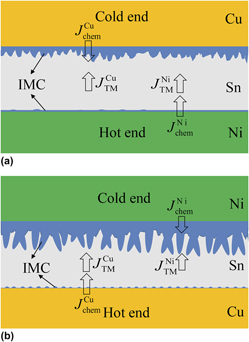Crossref Citations
This article has been cited by the following publications. This list is generated based on data provided by
Crossref.
Zhao, N.
Zhong, Y.
Huang, M.L.
Ma, H.T.
and
Dong, W.
2016.
Dissolution and precipitation kinetics of Cu6Sn5 intermetallics in Cu/Sn/Cu micro interconnects under temperature gradient.
Intermetallics,
Vol. 79,
Issue. ,
p.
28.
Zhao, Ning
Deng, Jianfeng
Zhong, Yi
Huang, Mingliang
and
Ma, Haitao
2016.
Interfacial reaction of Ni/Sn-9Zn/Ni solder joint undergoing liquid-solid thermomigration.
p.
273.
Zhong, Y.
Zhao, N.
Ma, H.T.
Dong, W.
and
Huang, M.L.
2017.
Retardation of thermomigration-induced Cu substrate consumption in Pb-free solder joints by Zn addition.
Journal of Alloys and Compounds,
Vol. 695,
Issue. ,
p.
1436.
Zhong, Yi
Zhao, Ning
Dong, Wei
Ma, Haitao
Huang, Mingliang
Yin, Luqiao
and
Wong, Chingping
2017.
Coupling effect of thermomigration and cross-interaction on evolution of intermetallic compounds in Cu/Sn/Ni ultrafine interconnects undergoing TLP bonding.
Journal of Materials Research,
Vol. 32,
Issue. 16,
p.
3128.
Zhao, Ning
Wang, Mingyao
Zhong, Yi
Ma, Haitao
Wang, Yunpeng
and
Wong, Ching-Ping
2017.
Study on interfacial reactions in Cu/Sn-9Zn/Ni micro solder joints under temperature gradient.
p.
1478.
Zhao, Ning
Deng, Jianfeng
Zhong, Yi
Ma, Haitao
Wang, Yunpeng
and
Wong, Ching-ping
2017.
Effect of Zn content on interfacial reactions of Ni/Sn–xZn/Ni joints under temperature gradient.
Journal of Materials Research,
Vol. 32,
Issue. 18,
p.
3555.
Zhong, Y.
Zhao, N.
Ma, H. T.
Dong, W.
Huang, M. L.
and
Wong, C. P.
2017.
Low Temperature Ni/Sn/Ni Transient Liquid Phase Bonding for High Temperature Packaging Applications by Imposing Temperature Gradient.
p.
411.
Zhao, N.
Deng, J. F.
Zhong, Y.
Huang, M. L.
and
Ma, H. T.
2017.
Abnormal Intermetallic Compound Evolution in Ni/Sn/Ni and Ni/Sn-9Zn/Ni Micro Solder Joints Under Thermomigration.
Journal of Electronic Materials,
Vol. 46,
Issue. 4,
p.
1931.
Guo, Bingfeng
Kunwar, Anil
Jiang, Chengrong
Zhao, Ning
Sun, Junhao
Chen, Jun
Wang, Yunpeng
Huang, Mingliang
and
Ma, Haitao
2018.
Synchrotron radiation imaging study on the rapid IMC growth of Sn–xAg solders with Cu and Ni substrates during the heat preservation stage.
Journal of Materials Science: Materials in Electronics,
Vol. 29,
Issue. 1,
p.
589.
Zhong, Y.
Zhao, N.
Dong, W.
Wang, Y.P.
and
Ma, H.T.
2018.
In situ study on the effect of Cu5Zn8 intermetallic layer on the Cu-Ni cross-interaction in Cu/Sn-9Zn/Ni interconnect under temperature gradient.
Materials Chemistry and Physics,
Vol. 216,
Issue. ,
p.
130.
Zhao, N.
Wang, M. Y.
Zhong, Y.
Ma, H. T.
Wang, Y. P.
and
Wong, C. P.
2018.
Effect of Zn content on Cu–Ni cross-interaction in Cu/Sn–xZn/Ni micro solder joints.
Journal of Materials Science: Materials in Electronics,
Vol. 29,
Issue. 6,
p.
5064.
Wang, Y. W.
Shih, W. L.
Hung, H. T.
and
Kao, C. R.
2019.
Reaction Within Ni/Sn/Cu Microjoints for Chip-Stacking Applications.
Journal of Electronic Materials,
Vol. 48,
Issue. 1,
p.
25.
Zhu, Ze
Chan, Yan-cheong
and
Wu, Fengshun
2019.
Effect of alternating current (AC) stressing on the microstructure and mechanical properties of low-silver content solder interconnect.
Microelectronics Reliability,
Vol. 92,
Issue. ,
p.
12.
Yang, Li
Zhou, Shiyuan
Zhang, Yaocheng
Xiong, Yifeng
Jiang, Wei
and
Shen, Sai
2020.
Microstructure and mechanical property of Cu/In–45Cu/Ni solder joints formed by transient liquid phase bonding.
Journal of Materials Research,
Vol. 35,
Issue. 21,
p.
2848.
Tian, Ye
Fang, Heng
Ren, Ning
Zhao, Yatao
Chen, Boli
Wu, Fengshun
and
Paik, Kyung-Wook
2020.
Reliable single-phase micro-joints with high melting point for 3D TSV chip stacking.
Journal of Alloys and Compounds,
Vol. 828,
Issue. ,
p.
154468.
Zhang, Peng
Xue, Songbai
and
Wang, Jianhao
2020.
New challenges of miniaturization of electronic devices: Electromigration and thermomigration in lead-free solder joints.
Materials & Design,
Vol. 192,
Issue. ,
p.
108726.
Ding, Zongye
Zhang, Naifang
Yu, Liao
Lu, Wenquan
Li, Jianguo
and
Hu, Qiaodan
2021.
Recent Progress in Metallurgical Bonding Mechanisms at the Liquid/Solid Interface of Dissimilar Metals Investigated via in situ X-ray Imaging Technologies.
Acta Metallurgica Sinica (English Letters),
Vol. 34,
Issue. 2,
p.
145.
Lai, Yanqing
Chen, Shi
Ren, Xiaolei
Qiao, Yuanyuan
and
Zhao, Ning
2022.
Growth behavior and morphology evolution of interfacial (Cu,Ni)6Sn5 in (001)Cu/Sn/Ni micro solder joints.
Materials Characterization,
Vol. 186,
Issue. ,
p.
111803.
Liang, Shuibao
Kunwar, Anil
Liu, Changqing
Jiang, Han
and
Zhou, Zhaoxia
2022.
Preferential growth of intermetallics under temperature gradient at Cu–Sn interface during transient liquid phase bonding: insights from phase field simulation.
Journal of Materials Research and Technology,
Vol. 19,
Issue. ,
p.
345.
Chao, Chen-Sung
Wu, Zih-You
Lee, Yin-Ku
Huang, Pin-Wei
Chang, Shou-Yi
Tsai, Su-Yueh
and
Duh, Jenq-Gong
2023.
Enhancing mechanical properties via the dual effect of Ni addition and temperature gradient for 5 μm Cu/Sn-3.0Ag-0.5Cu/Cu transient liquid phase bonding.
Materials Science and Engineering: A,
Vol. 870,
Issue. ,
p.
144863.





